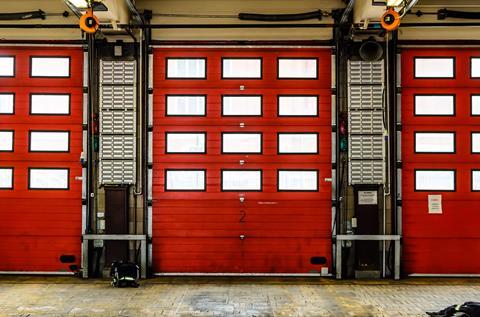UK fire crews play a vital role in saving lives. Due to the nature of the job, their facilities need more than just showers for clean-up. Andy Robinson explores how prioritizing decontamination pathways can ensure a safer environment for firefighters

Fire crews are at the front line of lifesaving in emergency services across the UK, requiring a dynamic, responsive and safe environment to carry out their daily operations.
However, the occupational health risks of being a firefighter are significant, and it doesn’t stop when the fire has been put out. Coming into contact with hazardous contaminants is a day-to-day occurrence for fire crews, making decontamination after a call out a hugely important part of the job.
Applying the principles of the Institution of Occupational Safety and Health’s No Time To Lose campaign, small solutions can make a big difference when it comes to occupational health risks. With fire crew facilities, this means an increased focus on how the spaces are used.
One way to do this effectively is by introducing a zoning approach in design that manages how people physically flow through a decontamination process when re-entering a station post-call out. This can hold the key to quick and efficient decontamination of both people and equipment, thereby lowering the onward decontamination risks for fire crews and fellow station users.
The particles left on clothing during a training exercise or call out can be transferred into the air and onto skin if not removed and cleaned properly, so an area is created between the rest of the building to make a separation for decontamination.
This zoning approach is being slowly integrated into fire stations and training facilities we are working on. The principles are common across the country, but each service is taking a different approach. Some are trying to keep all contaminants outside of buildings and deal with decontamination within the yard areas, enabling inside spaces to be clean. Others are looking for best practice, so that functions are graded depending on the operation cycle, using red, amber, green (RAG) coding to clarify the sensitivity.
Regardless of approach, the most important thing is that those using the facility go from ‘dirty’ to ‘clean’ as quickly as possible. What stations are trying to offer is the option to clean off at work, and while some will still choose to come home to shower, the risks of transferring potentially carcinogenic particles elsewhere during transit means that measures need to be put in place to ensure proper decontamination.

This principle also applies within the station and where the RAG system comes into its own. Once you’re through decontamination and into the clean zone, you can’t go backwards, and those different zones have different ventilation systems to avoid cross-contamination, with more powerful ventilation for extraction in the red zones.
The layout of existing fire stations varies, and each service has slightly different operational needs. Some buildings are too constrained to address this issue but other limitations to equality and diversity also contribute to the consideration for rebuilding.
As every site differs, feasibility studies are important – they can explore opportunities for phased intervention to limit impact on operations. Whilst the strategy may be similar, how this is deployed at each site will be modified to suit constraints and development options.
Regardless of approach, the most important thing is that those using the facility go from ‘dirty’ to ‘clean’ as quickly as possible.
When undertaking upgrades like this, it is important to consider other improvements that could be integrated. Many existing buildings were built for single gender operation, which suffer equality and diversity intentions, leading to compromises that can often be overcome with a simple solution. Conversely, many designs are now incorporating gender neutral dorm rooms, bathrooms and locker rooms into their facilities, striking a careful balance between crew cohesion and privacy.
The additional benefit of these investments within stations is that it opens up the prospect of wider improvements to the building fabric. With the net zero and decarbonisation agendas forming a key tenet of policy both nationally and internationally, the performance of all buildings is in sharp focus, so fire services are naturally looking for all improvements being made to feed into that approach.
Changes that can enhance the estate’s longevity while also enhancing thermal performance – such as the replacement of gas boilers and the use of renewable energy such as solar PV– contribute to the move towards net zero and a reduction in running costs. A key evidence point of this in action is the London Fire Brigade, which opened its first carbon zero fire station in Walthamstow last year. Its ‘green roof’ consists of natural wild planting, helping to keep the building cool in the summer and warm in the winter, with further improvements providing the blueprint for another 102 stations under an estate-wide strategy.
Combine these broader strategies with enhanced safety for team members brought about by the decontamination pathways, and you have a win-win situation for both the fire service and the firefighters.
Postscript
Andy Robinson, director at Pick Everard















No comments yet